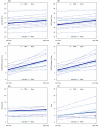Primed low-frequency repetitive transcranial magnetic stimulation and constraint-induced movement therapy in pediatric hemiparesis: a randomized controlled trial
- PMID: 23962321
- PMCID: PMC3864983
- DOI: 10.1111/dmcn.12243
Primed low-frequency repetitive transcranial magnetic stimulation and constraint-induced movement therapy in pediatric hemiparesis: a randomized controlled trial
Abstract
Aim: The aim of this study was to determine the feasibility and efficacy of five treatments of 6 Hz primed, low-frequency, repetitive transcranial magnetic stimulation (rTMS) combined with constraint-induced movement therapy (CIMT) to promote recovery of the paretic hand in children with congenital hemiparesis.
Method: Nineteen children with congenital hemiparesis aged between 8 and 17 years (10 males, nine females; mean age 10 years 10 months, SD 2 years 10 months; Manual Ability Classification Scale levels I-III) underwent five sessions of either real rTMS (n=10) or sham rTMS (n=9) alternated daily with CIMT. CIMT consisted of 13 days of continuous long-arm casting with five skin-check sessions. Each child received a total of 10 hours of one-to-one therapy. The primary outcome measure was the Assisting Hand Assessment (AHA) and the secondary outcome variables were the Canadian Occupational Performance Measure (COPM) and stereognosis. A Wilcoxon signed-rank sum test was used to analyze differences between pre- and post-test scores within the groups. Analysis of covariance was used to compute mean differences between groups adjusting for baseline. Fisher's exact test was used to compare individual change in AHA raw scores with the smallest detectable difference (SDD) of 4 points.
Results: All participants receiving treatment finished the study. Improvement in AHA differed significantly between groups (p=0.007). No significant differences in the secondary outcome measures were found. Eight out of 10 participants in the rTMS/CIMT group showed improvement greater than the SDD, but only two out of nine in the sham rTMS/CIMT group showed such improvement (p=0.023). No serious adverse events occurred.
Interpretation: Primed, low-frequency rTMS combined with CIMT appears to be safe, feasible, and efficacious in pediatric hemiparesis. Larger clinical trials are now indicated.
Trial registration: ClinicalTrials.gov NCT01104064.
© 2013 Mac Keith Press.
Figures


Comment in
-
Putting some excitement into constraint-induced movement therapy.Dev Med Child Neurol. 2014 Jan;56(1):5-6. doi: 10.1111/dmcn.12272. Epub 2013 Aug 26. Dev Med Child Neurol. 2014. PMID: 23980669 No abstract available.
-
Transcranial magnetic stimulation may improve symptoms of hemiparesis.J Pediatr. 2014 Jul;165(1):208-9. doi: 10.1016/j.jpeds.2014.04.024. J Pediatr. 2014. PMID: 24973163 No abstract available.
Similar articles
-
Repetitive Transcranial Magnetic Stimulation/Behavioral Intervention Clinical Trial: Long-Term Follow-Up of Outcomes in Congenital Hemiparesis.J Child Adolesc Psychopharmacol. 2016 Sep;26(7):598-605. doi: 10.1089/cap.2015.0157. Epub 2016 Feb 23. J Child Adolesc Psychopharmacol. 2016. PMID: 26905272 Free PMC article. Clinical Trial.
-
Brain stimulation and constraint for perinatal stroke hemiparesis: The PLASTIC CHAMPS Trial.Neurology. 2016 May 3;86(18):1659-67. doi: 10.1212/WNL.0000000000002646. Epub 2016 Mar 30. Neurology. 2016. PMID: 27029628 Free PMC article. Clinical Trial.
-
Contralesional repetitive transcranial magnetic stimulation for chronic hemiparesis in subcortical paediatric stroke: a randomised trial.Lancet Neurol. 2008 Jun;7(6):507-13. doi: 10.1016/S1474-4422(08)70096-6. Epub 2008 May 1. Lancet Neurol. 2008. PMID: 18455961 Clinical Trial.
-
Application of the CIT concept in the clinical environment: hurdles, practicalities, and clinical benefits.Cogn Behav Neurol. 2006 Mar;19(1):48-54. doi: 10.1097/00146965-200603000-00006. Cogn Behav Neurol. 2006. PMID: 16633019 Review.
-
Repetitive transcranial magnetic stimulation and constraint-induced movement therapy combined in the treatment of post-stroke movement disorders: a narrative review.Front Hum Neurosci. 2025 Apr 7;19:1578258. doi: 10.3389/fnhum.2025.1578258. eCollection 2025. Front Hum Neurosci. 2025. PMID: 40260173 Free PMC article. Review.
Cited by
-
Repetitive Transcranial Magnetic Stimulation/Behavioral Intervention Clinical Trial: Long-Term Follow-Up of Outcomes in Congenital Hemiparesis.J Child Adolesc Psychopharmacol. 2016 Sep;26(7):598-605. doi: 10.1089/cap.2015.0157. Epub 2016 Feb 23. J Child Adolesc Psychopharmacol. 2016. PMID: 26905272 Free PMC article. Clinical Trial.
-
Advances in the Diagnosis and Treatment of Pediatric Arterial Ischemic Stroke.Neurotherapeutics. 2023 Apr;20(3):633-654. doi: 10.1007/s13311-023-01373-5. Epub 2023 Apr 18. Neurotherapeutics. 2023. PMID: 37072548 Free PMC article. Review.
-
Rehabilitation and neuroplasticity in children with unilateral cerebral palsy.Nat Rev Neurol. 2015 Jul;11(7):390-400. doi: 10.1038/nrneurol.2015.97. Epub 2015 Jun 16. Nat Rev Neurol. 2015. PMID: 26077839 Review.
-
Determining Electrode Placement for Transcranial Direct Current Stimulation: A Comparison of EEG- Versus TMS-Guided Methods.Clin EEG Neurosci. 2017 Nov;48(6):367-375. doi: 10.1177/1550059417709177. Epub 2017 May 22. Clin EEG Neurosci. 2017. PMID: 28530154 Free PMC article.
-
Ipsilesional motor-evoked potential absence in pediatric hemiparesis impacts tracking accuracy of the less affected hand.Res Dev Disabil. 2015 Dec;47:154-64. doi: 10.1016/j.ridd.2015.09.010. Epub 2015 Sep 29. Res Dev Disabil. 2015. PMID: 26426515 Free PMC article.
References
-
- Hoare BJ, Wasiak J, Imms C, et al. Constraint-induced movement therapy in the treatment of the upper limb in children with hemiplegic cerebral palsy. Cochrane Database Syst Rev. 2007:004149. - PubMed
-
- Barker AT, Freeston IL, Jalinous R, et al. Magnetic stimulation of the human brain and peripheral nervous system: an introduction and the results of an initial clinical evaluation. Neurosurgery. 1987;20:100–9. - PubMed
-
- Pascual-Leone A, Valls-Solé J, Wassermann EM, Hallet M. Responses to rapid-rate transcranial magnetic stimulation of the human motor cortex. Brain. 1994;117:847–58. - PubMed
-
- Chen R, Classen J, Gerloff C, et al. Depression of motor cortex excitability by low-frequency transcranial magnetic stimulation. Neurology. 1997;48:1398–1403. - PubMed
Publication types
MeSH terms
Associated data
Grants and funding
LinkOut - more resources
Full Text Sources
Other Literature Sources
Medical

